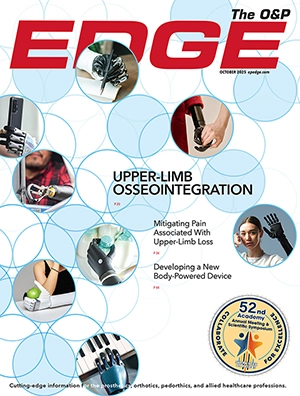Researchers at Johns Hopkins Applied Physics Laboratory (APL) have developed technology that allows people with amputations to perceive the sensation of cold in their phantom limbs, which could lead to sensation in prosthetic limbs. The wearable thin-film thermoelectric cooler (TFTEC), one of the world’s smallest, most intense and fastest refrigeration devices, once teamed with neuroscientists, was tested with people with amputations.
The TFTEC project started in 2016, when Rama Venkatasubramanian, PhD, a semiconductor device engineer and chief technologist for APL’s thermoelectrics research, began developing thermoelectric materials and devices for the Defense Advanced Research Projects Agency (DARPA) MATRIX program.
In 2019, Bobby Armiger, MS, who supervises APL’s Exploratory Science Branch, wondered if the technology could be used to facilitate temperature sensation in phantom limbs and advance prosthetic devices. APL has been leading DARPA’s Revolutionizing Prosthetics program since 2006, an effort focused on creating a mentally controlled artificial limb that will restore near-natural motor and sensory capability for people with upper-limb amputations.
“We’ve known that we can stimulate specific parts of someone’s amputated limb to feel sensations of touch and vibration, but no one has been able to create a cooling sensation with the speed, intensity, and efficiency to restore natural thermal perception with a prosthetic system,” Armiger said. “Restoring temperature sensation has practical applications—like identifying a cold beverage—as well as having the potential to improve the emotional embodiment of the prosthetic device, perhaps by feeling the warmth of a loved one’s hand.”
Venkatasubramanian and the thermoelectrics team began collaborating with Armiger and a team of neuroscientists and roboticists as part of a study supported by the Center for Rehabilitation Sciences Research at the Uniformed Services University of the Health Sciences (USU) to create a wearable thermoelectric cooler fast and intense enough to match the human body’s ability to rapidly sense temperature changes.
“Our TFTEC is just a little more than one millimeter thick, weighs only 0.05 grams, similar to a thin adhesive bandage, and can provide intense cooling in less than a second,” said Venkatasubramanian. “It’s also two times more energy efficient than today’s most common thermoelectric devices, and can be readily manufactured using semiconductor tools that are also used for manufacturing light-emitting diodes [LEDs]. It’s an exciting development that could have huge implications for prostheses and haptics applications.”
To test the TFTEC’s efficacy, researchers mapped thermal sensations in the phantom hands of four people with amputations.
“You can place electrodes on different parts of an amputee’s upper arm where those nerves have regrown and stimulate sensation—typically pressure, but in the current case, temperature—and the individual can tell us where in their phantom hand they feel those sensations.” said Luke Osborn, a neuroengineering researcher who leads much of APL’s noninvasive nerve simulation work.
The study about the development said that the TFTEC elicited cooling sensations in the phantom limbs of all participants during a cold detection task, whereas traditional thermoelectric technology only did so in half of them—and the TFTEC did so eight times faster and with three times the intensity. Additionally, TFTEC used half the energy compared to current thermoelectric devices.
“We found that the TFTEC device was significantly better at creating faster and more intense cooling sensations compared to traditional devices, even though the target temperature was the same,” said Osborn. “And that helped participants make faster decisions and observations.”
The stimulation sites on test participants remained the same over 48 weeks of testing, suggesting that the technology could enable users to feel temperature in their missing hands for years. This temporal stability along with a wearable noninvasive procedure are attractive for adoption to real-world use.
“It has been great to see the translation of this APL-developed thermoelectric technology into the healthcare domain through this first-of-its-kind demonstration in an amputee,” said David Drewry, a biomedical engineer and program manager within APL’s National Health Mission Area. “We look forward to expanding the results in more robust clinical trials and integrating the device into other wearable form factors that can be readily deployed to individuals in need of sensory restoration or haptic feedback.”
The technology could also be used in augmented reality, pain management, and in cooling electronics and lasers and energy-harvesting in satellites.
The study, “Evoking natural thermal perceptions using a thin-film thermoelectric device with high cooling power density and speed,” was published in Nature Biomedical Engineering.
Editor’s note: This story was adapted from materials provided by Johns Hopkins Applied Physics Laboratory.
To watch a video about the work, visit the Johns Hopkins Applied Physics Laboratory YouTube page.




